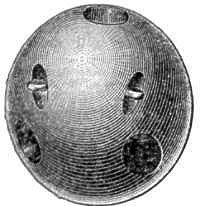161:. For the shell, he started with two iron rings (others used plates), fitting one at one extreme, near the aperture at which the carcass was to be fired, and the other at the other. These he braced with cords drawn lengthwise; and across these, at right angles, laced other cords, making a knot at each intersection. Between the folds of the cords, he made holes, inserted copper tubes, and filled them half full of powder and lead bullets, packing it in with a tow. The internal shell's aperture was then plugged up, and it was immersed in a mixture of 4 parts of melted
253:
116:
shell of the period, the carcass had 3 openings, each 3 inches (76 mm) in diameter. Its filling burned for 11 minutes upon firing. It was especially useful during night bombardments, as the burning projectile assisted in the aiming of the cannon.
20:
267:
46:, filled with a highly flammable mixture, and having three to five holes through which the burning filling could blaze outward. Carcasses were shot from
173:, and as much ground gunpowder as was needed to reduce it to the consistency of a paste. After immersion, the shell was to be covered with
281:
73:
because the circles which pass from one ring, or plate, to the other, were thought to resemble the ribs of a human
126:
180:
Carcass shells as used by the Royal Navy from the 18th to the 19th centuries were filled with a mixture of
340:
330:
285:
32:
125:
For the composition of the flammable material used in a carcass, 18th century philosopher
8:
86:
108:, was a hollow cast iron sphere weighing 190 pounds (86 kg). Instead of the single
59:
39:
62:; on impact, the shell shattered, spreading its incendiary filling around the target.
181:
170:
90:
262:
304:
290:
210:
113:
85:
Carcasses were used for the first time by the French and Münsterite troops under
63:
51:
335:
109:
42:, intended to set targets on fire. It comprised an external casing, usually of
324:
257:
162:
154:
105:
174:
94:
145:; or 6 of gunpowder, 4 of nitre, 4 of sulfur, 1 of beaten glass, 0.5 of
215:
193:
101:
142:
130:
43:
256: This article incorporates text from a publication now in the
185:
177:, and immersed again, until it was the proper size for the mortar.
146:
104:
in the 18th and early 19th century, most famously in the attack on
47:
150:
74:
19:
205:
189:
138:
55:
305:"HMS Volcano: and the Carcasses Red Glare, September 13, 1814"
166:
134:
268:
Cyclopædia, or an
Universal Dictionary of Arts and Sciences
158:
35:
322:
66:were also sometimes fitted with carcass heads.
271:(1st ed.). James and John Knapton, et al.
237:. Oxford University Press. 2nd edition. 1989.
261:
18:
247:
245:
243:
323:
16:Early form of incendiary bomb or shell
291:Elements of Military Art and History
240:
93:in 1672. They were also fired from
13:
227:
14:
352:
282:Nicolas Édouard Delabarre-Duparcq
100:The carcass shell as used by the
251:
129:prescribed 10 parts of pounded
297:
275:
120:
1:
221:
112:hole found on a conventional
58:to set fire to buildings and
7:
199:
10:
357:
80:
23:Drawing of a carcass shell
265:, ed. (1728). "Carcass".
235:Oxford English Dictionary
286:George Washington Cullum
24:
157:, and 0.25 of common
31:was an early form of
22:
186:sulfide of antimony
341:Incendiary weapons
307:. ScienceViews.com
25:
263:Chambers, Ephraim
184:, sulfur, rosin,
171:oil of turpentine
91:Bernard von Galen
348:
331:Artillery shells
316:
315:
313:
312:
301:
295:
279:
273:
272:
255:
254:
249:
238:
231:
69:They were named
64:Congreve rockets
356:
355:
351:
350:
349:
347:
346:
345:
321:
320:
319:
310:
308:
303:
302:
298:
280:
276:
252:
250:
241:
232:
228:
224:
211:Incendiary bomb
202:
127:Christian Wolff
123:
83:
17:
12:
11:
5:
354:
344:
343:
338:
333:
318:
317:
296:
294:. 1863. p 142.
274:
239:
225:
223:
220:
219:
218:
213:
208:
201:
198:
122:
119:
82:
79:
15:
9:
6:
4:
3:
2:
353:
342:
339:
337:
334:
332:
329:
328:
326:
306:
300:
293:
292:
287:
283:
278:
270:
269:
264:
259:
258:public domain
248:
246:
244:
236:
230:
226:
217:
214:
212:
209:
207:
204:
203:
197:
195:
191:
187:
183:
178:
176:
172:
168:
164:
160:
156:
152:
148:
144:
140:
136:
132:
128:
118:
115:
111:
107:
103:
98:
96:
92:
88:
78:
76:
72:
67:
65:
61:
57:
53:
49:
45:
41:
37:
34:
30:
21:
309:. Retrieved
299:
289:
277:
266:
234:
229:
179:
155:sal ammoniac
124:
106:Fort McHenry
99:
95:bomb vessels
84:
70:
68:
54:, and other
28:
26:
233:"Carcass".
141:, and 1 of
121:Composition
325:Categories
311:2008-07-07
222:References
216:Greek fire
194:turpentine
102:Royal Navy
33:incendiary
182:saltpeter
143:colophony
131:gunpowder
87:Louis XIV
48:howitzers
44:cast iron
200:See also
165:, 20 of
147:antimony
60:defences
260::
169:, 1 of
153:, 1 of
151:camphor
149:0.5 of
137:, 1 of
133:, 2 of
81:History
75:carcass
71:carcass
56:cannons
52:mortars
29:carcass
206:Napalm
190:tallow
139:sulfur
114:mortar
336:Bombs
167:rosin
163:pitch
135:nitre
40:shell
284:and
192:and
159:salt
110:fuse
89:and
36:bomb
175:tow
38:or
327::
288:.
242:^
196:.
188:,
97:.
77:.
50:,
27:A
314:.
Text is available under the Creative Commons Attribution-ShareAlike License. Additional terms may apply.
